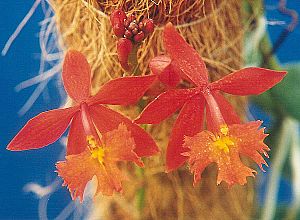Ground-rooting epidendrum facts for kids
Quick facts for kids Ground-rooting epidendrum |
|
|---|---|
 |
|
| Scientific classification | |
| Genus: |
Epidendrum
|
| Species: |
radicans
|
Epidendrum radicans is a type of orchid plant. It has many common names, like ground-rooting epidendrum, fire-star orchid, rainbow orchid, and reed-stem epidendrum. You can often find this orchid growing like a common plant along roadsides in Central America, especially in places that are not too high up.
This orchid is part of a group called "crucifix orchids." It can sometimes be confused with other similar orchids, but E. radicans has a special feature: it grows roots all along its stem. Most other crucifix orchids only grow roots near the bottom of the plant. Also, the flowers of E. radicans are resupinate, which means they are upside down compared to how they first grow. Unlike some other crucifix orchids, E. radicans flowers do not produce any nectar.
What Does It Look Like?
E. radicans grows in a special way, like other orchids in its group. Its stems do not swell up into big, round shapes (called pseudobulbs). Instead, they are covered with overlapping layers. The flowers grow at the very top of the stem.
The most unique part of the E. radicans flower is its "lip." This is a special petal that is joined to the central part of the flower (the column) all the way to its tip. The lip of E. radicans has three parts, and these parts look torn or jagged. This jagged look is common in its orchid family. The main way to tell E. radicans apart from other similar orchids is that it grows roots from almost its entire stem.
The seeds of E. radicans are very tiny. About 320 of them would weigh just one milligram!
Where It Lives and How It Grows
E. radicans is part of a group of plants that all have orange flowers and often grow in similar places, even though they are not closely related. This group includes plants like Asclepias curassavica (a type of milkweed) and Lantana camara. These different plants share the same pollinators, like bees or butterflies, and live in similar environments.
When unrelated species start to look alike because they live in similar places and face similar challenges, it's called convergent evolution. It means they "converge" or come together on similar features. Scientists have studied these plants to see if they are mimicking each other's flowers to attract pollinators, but clear evidence for this has not been found for these specific species.
See also
 In Spanish: Epidendrum radicans para niños
In Spanish: Epidendrum radicans para niños

